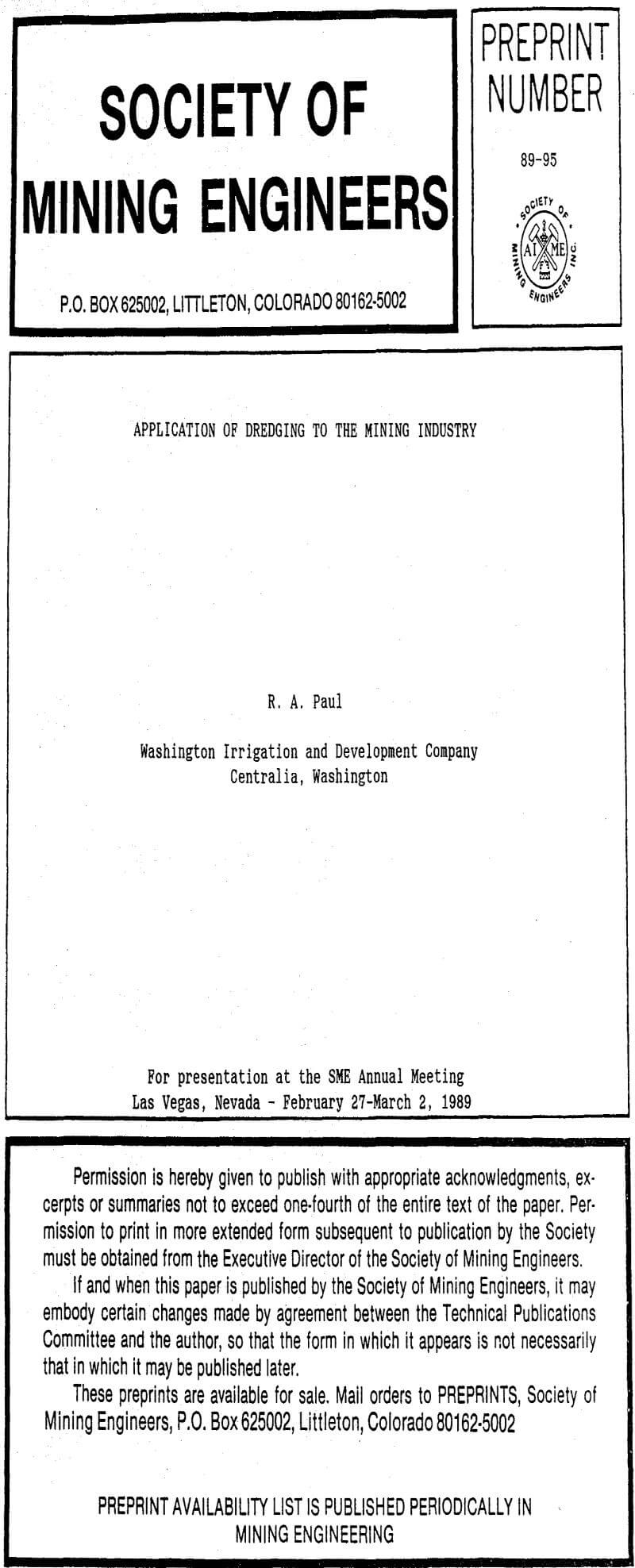The dredge selected for the project was the Para. It is purportedly the largest discountable dredge in the world. Two weeks after its arrival at the project site by rail, the Para was ready to operate. The Para has a 0.75 m (29½ inch) suction and a 0.70 m (27½ inch) discharge. It has 600 horsepower to the cutter, and 2,200 horsepower to the main pump. It is fitted with a spud carriage which enhances mobility and facilitates making straight dredge cuts. Although the Para has its own diesel powered DC electric generators, it was fed electricity directly from the mine grid, thereby reducing operating costs. The Para is well instrumented and computer controlled. It has the ability to automatically cut a design slope. The contractor provided very experienced crews to man the Para as well as excellent technical support.
Problems
Two major problems were encountered during the dredging project. The first was the bulking factor of the dredge spoils. The bulking factor was estimated by an engineering consultant from laboratory test data to be 1.35. The laboratory data and consultant’s estimate were reviewed and accepted by the contractors submitting proposals for the work. To be conservative, the owner used a 1.5 bulking factor for planning. At this point in time, with the settling process essentially completed and the consolidation ongoing, the overall bulking factor is 1.84. During the actual dredging, the bulking factor averaged approximately 2.0, occasionally reaching maximums up to 4.0. With the estimated volume of the disposal site at 7 Mm³ (9.1 Myd³ ), the volume of dredge spoils exceeded the capacity of the disposal site when the average bulking factor exceeded 1.8. Additional water had to be added to the system to make up for the increase in bulking factor. Raising the rim of the disposal area to increase its capacity and adding additional working water to the dredging system resulted in a total of eight weeks delay. To date, the reasons for underestimating the bulking factor have not been determined.

The second major problem encountered during the dredging project was obstacles. They were primarily of two types, wood and boulders. The surface of the ground had been cleared of all trees, brush, and debris; but, tons of cedar, a wood that does not deteriorate with time, were buried in the sediments. With a “knife” installed in the dredge pump, the buried wood was readily reduced in size and passed through the slurry line to the disposal area. However, if boulders were present, the knife was quickly destroyed and the pump clogged with wood. In this particular situation, the boulders did not naturally occur in the sediments, but were imported in the man-made fills on and around the dredge area. Initially, the owner had no appreciation of what constituted an obstacle to the dredge. The owner had removed the large boulders from the project area which would block the swing of the dredge ladder, but had left behind smaller boulders which could enter the dredge suction and block the pump. Problems with obstacles resulted in a total of three weeks of delays.
WIDCO was very concerned about the depth and total volume of spillage that would be left by the dredge. Subsequent clean-up and removal of such spillage with conventional equipment are costly and difficult. WIDCO had asked prospective bidders to limit the spillage to an average of 0.1 m (4 inches). The contractors indicated that an average of 0.23 m (9 inches) were more practical and cost effective. A post-dredging survey, conducted in accessible areas, indicated an average of 0.14 m (5½ inches) of spillage left after the dredging had been completed.
Recommendations
WIDCO’s experience suggests that in the right conditions, dredging can be an appropriate and cost effective method of moving material in a surface mining operation. Two primary considerations should be material type and the availability of water. Various types of dredges could be used for excavation and transport of overburden, the excavation and transportation of the mineral materials, excavation and direct processing of alluvial heavy mineral deposits, and the cleaning of slurry and sediment ponds.
In most cases, applications of dredging in the mining industry will be inland and closed circuit. Such applications are significantly different in several important aspects from the river and harbor maintenance typical of the dredging industry. These differences must be considered in site evaluation, engineering design, and contractor selection for the application to be successful.
